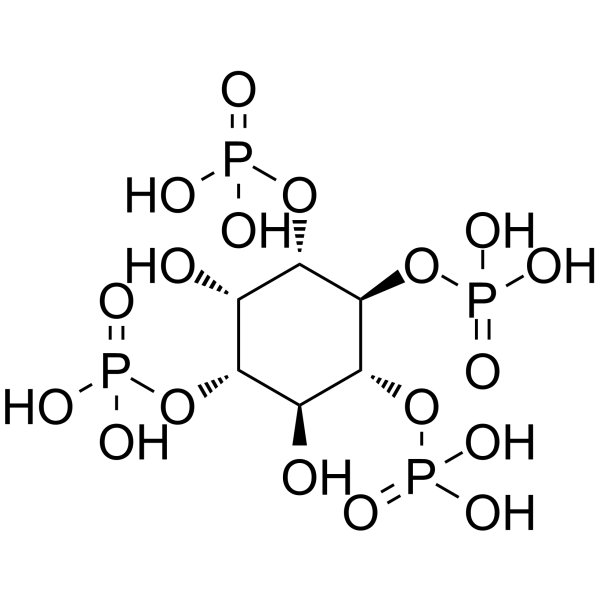D-肌醇-1,3,4,5-四(磷酸)铵盐

D-肌醇-1,3,4,5-四(磷酸)铵盐结构式

|
常用名 | D-肌醇-1,3,4,5-四(磷酸)铵盐 | 英文名 | Inositol 1,3,4,5-tetraphosphate |
|---|---|---|---|---|
| CAS号 | 102850-29-3 | 分子量 | 517.10600 | |
| 密度 | 2.32 g/cm3 | 沸点 | 1015.6ºC at 760 mmHg | |
| 分子式 | C6H16O18P4 | 熔点 | N/A | |
| MSDS | 美版 | 闪点 | 568ºC |
|
IP3 3-kinase B controls hematopoietic stem cell homeostasis and prevents lethal hematopoietic failure in mice.
Blood 125 , 2786-97, (2015) Tight regulation of hematopoietic stem cell (HSC) homeostasis ensures lifelong hematopoiesis and prevents blood cancers. The mechanisms balancing HSC quiescence with expansion and differentiation into hematopoietic progenitors are incompletely understood. Her... |
|
|
Cell signaling. The art of the soluble.
Science 316(5826) , 845-6, (2007)
|
|
|
Interaction of the brain-specific protein p42IP4/centaurin-alpha1 with the peptidase nardilysin is regulated by the cognate ligands of p42IP4, PtdIns(3,4,5)P3 and Ins(1,3,4,5)P4, with stereospecificity.
J. Neurochem. 98(2) , 343-54, (2006) The brain-specific protein p42IP4, also called centaurin-alpha1, specifically binds phosphatidylinositol 3,4,5-trisphosphate [PtdIns(3,4,5)P3] and inositol 1,3,4,5-tetrakisphosphate [Ins(1,3,4,5)P4]. Here, we investigate the interaction of p42IP4/centaurin-al... |
|
|
Inositol 1,4,5-trisphosphate 3-kinase B is a negative regulator of BCR signaling that controls B cell selection and tolerance induction.
J. Immunol. 182(8) , 4696-704, (2009) Inositol 1,4,5-trisphosphate 3-kinase B (or Itpkb) converts inositol 1,4,5-trisphosphate to inositol 1,3,4,5-tetrakisphosphate upon Ag receptor activation and controls the fate and function of lymphocytes. To determine the role of Itpkb in B cell tolerance, I... |
|
|
Regioselective deprotection of orthobenzoates for the synthesis of inositol phosphates.
Org. Biomol. Chem. 7(8) , 1709-15, (2009) Synthetic myo-inositol 1,4,5-triphosphate, Ins(1,4,5)P(3), and myo-inositol 1,3,4,5-tetraphosphate, Ins(1,3,4,5)P(4), continue to be valuable in biological studies. Inositol orthoesters have proved an important class of intermediate to access these compounds.... |
|
|
Beyond IP3: roles for higher order inositol phosphates in immune cell signaling.
Cell Cycle 7(4) , 463-7, (2008) Nearly 25 years ago the first function of an inositol phosphate, namely Ins(1,4,5)P3, was reported to act as a "second messenger" to mobilize calcium from the endoplasmic reticulum (ER). Since this discovery, many other inositol phosphates and the kinases and... |
|
|
Mobility of proteins associated with the plasma membrane by interaction with inositol lipids.
J. Cell Sci. 118(Pt 14) , 3019-25, (2005) Translocation of a protein to the plasma membrane in response to the generation of polyphosphoinositol lipids is believed to be an important component of cellular regulation, in part because it increases the effective concentration of that protein relative to... |
|
|
Mechanism regulating nuclear calcium signaling.
Can. J. Physiol. Pharmacol. 84(3-4) , 403-22, (2006) Although the outer nuclear membrane is continuous with the endoplasmic reticulum, it is possible to isolate nuclei both intact and free from endoplasmic reticulum contaminants. The outer and the inner nuclear membranes can be purified free from cross-contamin... |
|
|
A theoretical investigation of inositol 1,3,4,5-tetrakisphosphate.
Phys. Chem. Chem. Phys. 13(3) , 1070-81, (2011) This paper describes the parameterization of inositol 1,3,4,5-tetrakisphosphate [Ins(1,3,4,5)P(4)] for use in molecular dynamics (MD) simulations. For this theoretical investigation, eleven isomers of Ins(1,3,4,5)P(4), with different levels and arrangements o... |
|
|
The structural integrity of the endoplasmic reticulum, and its possible regulation by inositol 1,3,4,5-tetrakisphosphate.
Cell Calcium 38(2) , 153-9, (2005) The endoplasmic reticulum (ER) is a dynamic organelle thought to consist of a single interconnected network of membranes. Using fluorescence recovery after photobleaching (FRAP) of HEK-293 cells dually transfected with soluble fluorescent proteins targeted to... |